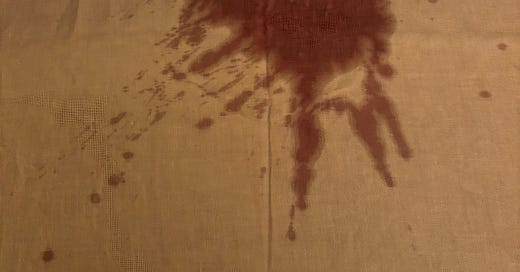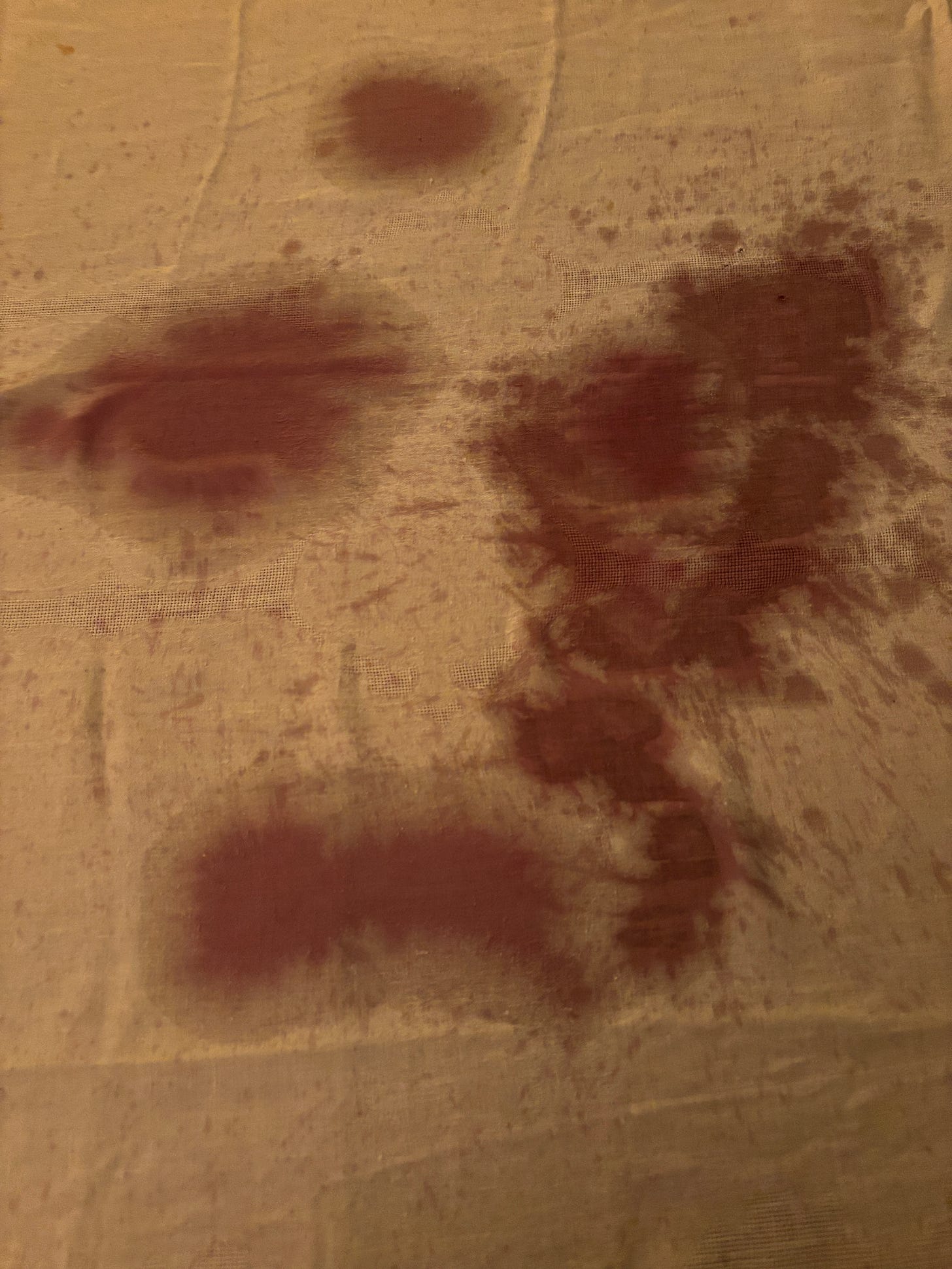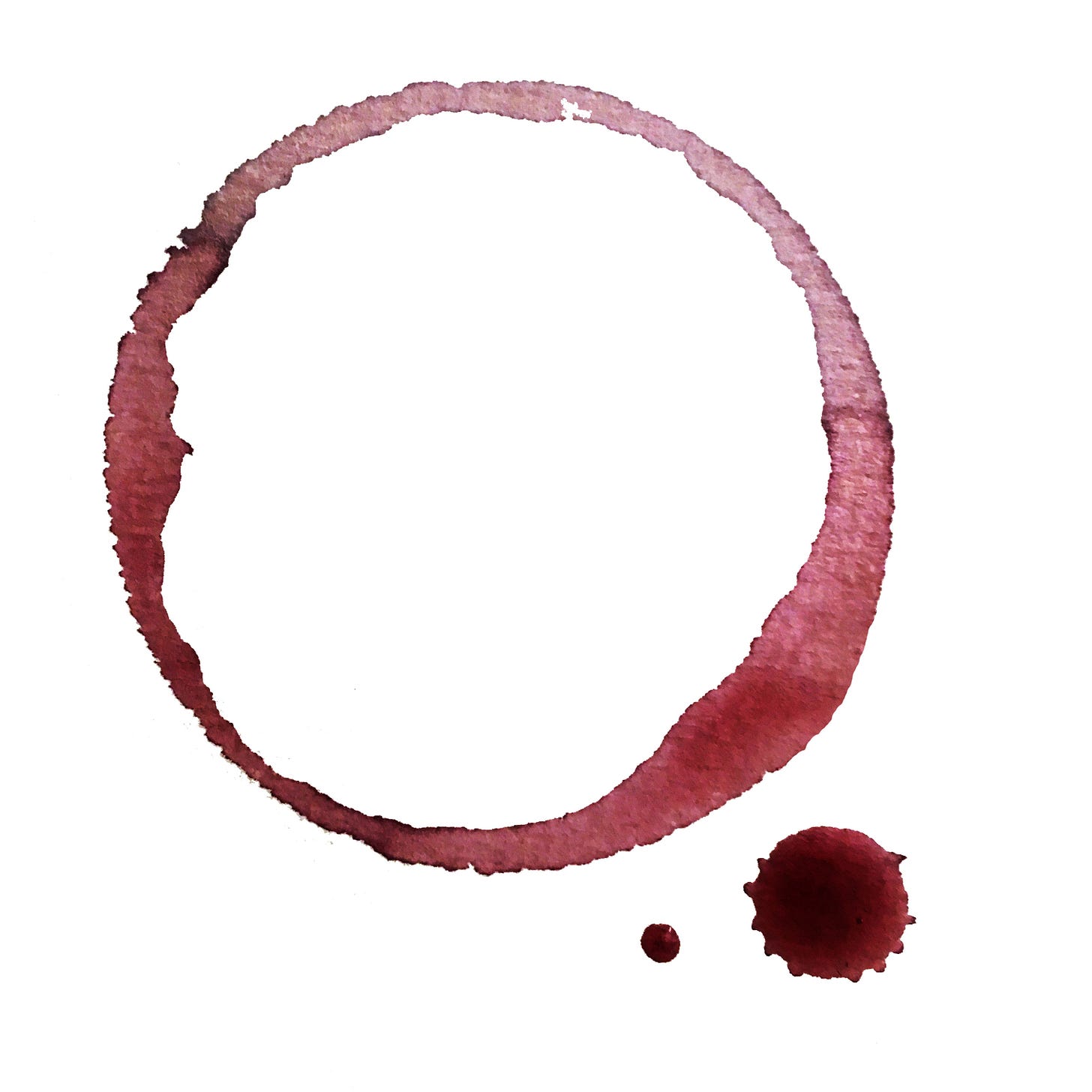“Spill the wine, take that pearl.” (Eric Burden and War)
The irregular combination of fanciful invention may delight awhile by that novelty of which the common satiety of life sends us all in quest. But the pleasures of sudden wonder are soon exhausted and the mind can only repose on the stability of truth… Samuel Johnson
I can thank my friend Sabine Mirlesse who is interested in geomancy for the idea of this post. She simply sent me the word ‘oenomancy’ in a text, and I was immediately captivated. So, carrying on from the spiritual, mystical dimension of wine evoked in last week’s post about ‘All Soul’s Day’, this week we’re looking into oenomancy - the ancient art of wine divination.
I think it rare that anyone would intentionally spill wine, as spilled wine, unlike spilled milk, IS something to cry over. Intentionally or not, it happens, and when it does, rather than getting upset, you might instead try your hand at ‘reading’ the shapes it makes to gain insight into specific situations, or to see what the future holds. So what exactly is oenomancy and how does one go about becoming an oenomancer?

The following definition has been lifted directly from Occult World (https://occult-world.com/oinomancy/)
Oinomancy
Oinomancy (or oenomancy or œnomancy) is a form of divination by interpreting the patterns in wine.
Etymology
Derived from the Greek oinos ('wine') and manteia ('prophecy')
Origin
Oinomancy can be traced back from ancient Greece and Rome where wine was poured as a libation to the gods, hoping for a prosperous future. The ancient practice was performed by a priestess known as a Bacchante, and protected by Bacchus, the Roman god of wine.
Methods
Oinomancy could be done in various ways:
Spilling out the wine on a cloth or paper and examining the stains
Soaking or boiling a cloth or paper in wine and evaluating the patterns formed on the material
Pouring a wine as an offering during libation and observing its appearance
Studying the sediments formed in a glass or bottle of wine
Studying the physical features of wine such as color and taste
The procedure known as the 'three vases of Artephius' is a divinatory method related to the magic mirror, hydromancy, and oinomancy.
No doubt the Cartesian minds out there will resist this ancient practice, asserting, to begin with, that there are no gods, and that divination is projection and at the same level as interpreting dreams, astrology, tarot cards, or reading tea leaves (tasseography). Supernatural phenomenon cannot be trusted, and any attempt to derive meaning from the random act of spilling wine is complete nonsense.
Well, yes, perhaps it is. But humans are pattern seekers and our imaginations inspire all manner of fanciful ideas that might seem far-fetched and silly to the more rational among us. The intuitive on the other hand, and those with high levels of insight, may see this as self-evident, as wine is a symbol of life, directly linked to the divine, and therefore just another approach to solving the riddles of the universe and the mysteries and signs that surround us.
The following definition of divination is from Brittanica (https://www.britannica.com/topic/divination)
Divination, the practice of determining the hidden significance or cause of events, sometimes foretelling the future, by various natural, psychological, and other techniques. Found in all civilizations, both ancient and modern, it is encountered most frequently in contemporary mass society in the form of horoscopes, astrology, crystal gazing, tarot cards, and the Ouija board.
In the context of ancient Roman culture and belief, divination was concerned with discovering the will of the gods. Today, however, scholars no longer restrict the word to the root meaning. Divinatory practices and the beliefs undergirding them are greater in scope than discerning the will of the gods and the fatalistic view of the human condition that inspired so much of early Mediterranean religious thought. In some societies, in fact, divination is a practice to which many persons frequently resort, but never in terms of discovering the will of the gods. The idea of a godly providence controlling human affairs in such societies is unusual, although humbler spirits are often thought to intervene in troublesome ways. While divination is most commonly practiced in the modern Western world in the form of horoscopic astrology, other forms were and continue to be of equal importance for other cultures.
Not having any Bacchants or priests versed in oenomancy on hand, and with nothing other than our intuition to guide us, we decided to experiment to see what we might ‘read’ from this ancient practice. To begin, it goes without saying we only used ‘living’ wines, those produced without any chemical intervention or inputs (nothing added, nothing taken away) as we’re pretty certain that industrial wines would only tell tales of woe, if they ‘spoke’ at all.

According to a variety of unrelated sources, one should begin by setting the scene. Suggestions include being in a quiet, clean space free from distractions; lighting candles and incense to create a ‘sacred’ atmosphere (we also lit a fire in the fireplace) and taking into account the phases of the moon (waxing crescent on Sunday 3 November, the day of our experimentation).
What isn’t mentioned is drinking wine before you begin, which we decided was essential in order to be imbued with the soul of the wine and to be as open as possible to the messages the wine might give us. I should point out that we used an organic box wine for the spills, and drank a 2018 Chenas from Anthony Thevenet for inspiration and ‘spiritual connection’.
One then takes the wine (natural, living, red) in hand and tries to focus intention. As a predominantly anglophone group believing in the social benefits of democracy, we initially decided to set our intention collectively. The suggested procedure is to pour a small amount of wine into a clear glass and then spill it onto a flat surface. I chose a white(ish) table-cloth that already had a large wine stain that I’ve never managed to remove.
We intended to try two different approaches. Accidental and intentional. The accidental meant setting up wine glasses in a precarious manner so as to encourage the possibility of an accident. Which you might think defeats the purpose as there is already intention involved in trying to cause an accident. But luckily (?) for us, there was a real accident, so we can safely say this approach was not rigged in any way.
Looking at the patterns created by the wine, we took into account fluidity, and then tried to make sense of the shapes and patterns. It is suggested that circles often symbolise completion or wholeness. Lines or arrows might indicate direction or movement toward a goal, while swirls are evocative of confusion, and complexity. It is thought that a clear pattern implies a straightforward, untroubled situation, while chaotic shapes indicate uncertainty or conflict (you need to interpret all of this as you will). If the wine creates thick, heavy shapes, it might suggest strong emotions or obstacles. Shades of differing intensity can be read as positive or negative in the rather predictable and simplistic manner of dark being negative and light being positive. You decide.
What was truly exciting about all of this was how immediate, emphatic, and certain the interpretations were. Everyone (we were four) had instantaneous and clear readings of the various shapes, meeting with agreement and recognition with subsequent readings also ‘seen’ collectively.
It is suggested that one writes all this down for future reference so as to track patterns over time, and that with any form of divination, the effectiveness often lies in the practitioner's intuition and connection to the practice. Embrace the experience, and let the wine guide your insights! we are told. In this regard, we’re quite certain that drinking wine while engaging in this curious practice, helped us ‘read’ the patterns created by these random outpourings.

Wine Spill #1
This happened while discussing how to proceed, speaking of intention and how we might collectively choose a burning issue or polemic and ask the wine spill to speak about that. Although the outcome of the US elections was prominent in everyone’s mind, we avoided that nest of vipers in favour of less obvious topics, in the end leaving intentions un-said and simply trying to be present. But while pouring wine from one glass to another, I somehow spilled most of the glass on to the cloth. The picture above, which I think in many ways was the most complex image, immediately inspired us, and we were suddenly in.
The reading
Bug, possibly in flight, strong emotion, lots of spots, jagged, heart, confused, ‘splat’ but incredibly coherent… As this was our first attempt, we didn’t go as deep as we might have, keen as we were to try an intentional spill.
The intentional approach involved deliberately pouring wine onto a cloth. What comes into play here is whatever thoughts are in one’s mind while performing this gesture. The intention is therefore connected to a question, a thought, a doubt, or ‘the eternal sunshine of the spotless mind’.
Wine spills #2, 3, 4, 5 (intentional)
After discussing a broad range of possible ‘questions’ we decided to ask whether Paris is right for us. We each spilled a bit of wine onto the cloth and then collectively interpreted the results.
The readings
GF Phallic shape, which was then interpreted as a comet, ball of fire, and a note of music. Showed direction.
KW Arrowhead, with an angel or mentor accompanying, or something that is being passed by. Moving towards a person, (faint image), perhaps the future. This image was later splashed over (accidentally) by another spill, so the original image is not visible here.
MT Virus, circle, black mould, organic shape, coming full circle, coming home, family, burgeoning direction.
TH Puffer fish, aquatic, amoeba, flounder, heart with a stake driven into it, the sea is calling…
Wine spill #6 (intentional)
This was a spill that was created collectively with all of us holding on to the glass, lowering it and then abruptly bringing it upwards releasing the wine in an upward flow that splashed over KW’s earlier spill. There wasn’t a specific question, just everyone trying to ‘be in the moment’.
The reading
‘Finding Nemo’, fragmented, people dancing, creature with a fluffy tail, figure with a spiky crown, Madagascar, Italy, Sicily…
Wine spills #7, 8, 9, 10 (intentional)
This time we turned our backs to the table, pouring the wine out without looking.
GF Blue Meanie (from the Beatles film ‘Yellow Submarine’), Sumo wrestler, dog, clown…
KW Leaping lamb, counting sheep, Christmas stocking…
TH Bird shape, water pouring…
MT Initial round shape that somehow evolved into a square…
Did we learn anything? Were our questions and intentions resolved in any way? I can’t say we took any of this very seriously and came at it in a spirit of curiosity and fun, with open minds, but with rigorous scientific application (we scrupulously observed the guidelines for setting, creating a ‘sacred’ space, focussing intention and noting the outcome). None of us were really surprised to discover that divine communication through the medium of wine was practiced by the ancients. We were all intrigued by the possibilities, recognising at the same time our own limitations in being adept at making sense of any of it. But it was fun and a rather unique reason to gather, and of course, drink wine.
Conclusion? We’d still rather drink wine than spill it, and therein, perhaps be inspired to unravel the riddles of the universe and give life a meaning (because of the obvious fact that it has no meaning - to paraphrase Henry Miller).
The above was written before the American election, which now adds an additional tone to the notion that life has no meaning, not to mention that ‘the mind can only repose on the stability of truth’.
Thank you for letting me into your world and for reading the Paris Wine Walks Substack. Your support is invaluable as are your comments, suggestions, critiques, dreams, thoughts and remembrances. A little encouragement goes a long way, so please consider a paid subscription, which need cost no more than (a cheap) glass of wine per week. Or, book a wine walk!
My book, ‘The Hidden Vineyards of Paris’ (reviewed in Jancis Robinson’s wine blog, the Wine Economist, National Geographic Traveler UK, UK Telegraph) is available for purchase via our website and at anglophone bookshops and wine shops in Paris. You can also find it at the Musée de Montmartre and the Librairie Gourmande.
Wine Walks!
For more information, click on the underlined links:
Sparkling Wine Splash!
Share a sparkling, convivial moment with colleagues, friends or clients to celebrate the moment or to simply gather for fun.
Clos Montmartre - Paris in Your Glass
Paris' most famous wine producing vineyard
Latin Quarter Unbottled!
An insider's journey to the oldest wine neighbourhood in the city
Belleville Unbottled!
A winebar crawl that features some of the best winebars in the city
Wine Your Way Through the Marais
The Marais seen through a wineglass
Saint-Germain-des-Prés
Discover the vinous spirit of medieval Paris
3-Vineyard Cycling Tour
A comprehensive overview of medieval Paris
Paris Bottled!
Short on time? This one’s for you.
Drink responsibly, drink sustainably, in moderation
Paris Wine Walks is a reader-supported publication. To receive new posts and support my work, consider becoming a free or paid subscriber.






